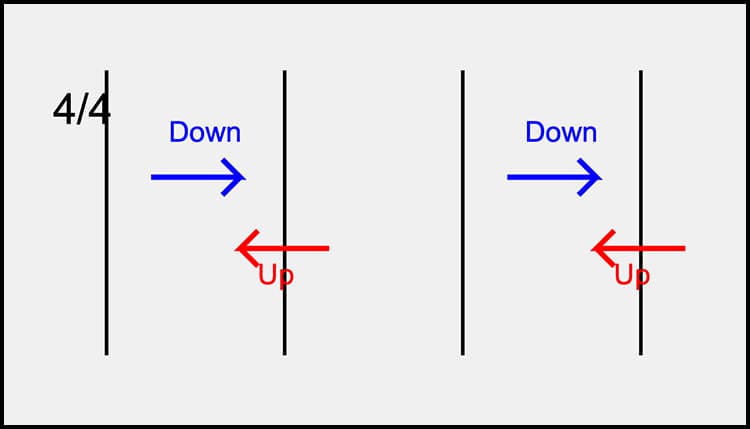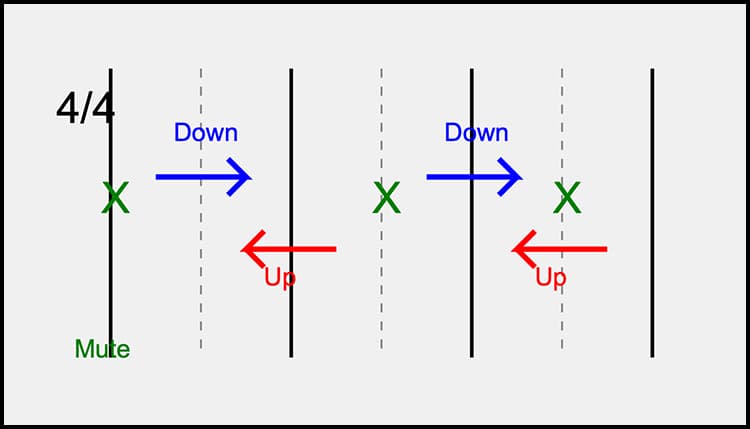Ever picked up a guitar and felt lost about how to make those sweet, rhythmic sounds? You’re not alone!
In fact, a whopping 90% of new guitarists struggle with strumming techniques. But don’t fret (pun intended)!
Whether you’re a total newbie figuring out how to play guitar or looking to refine your skills, learning how to strum a guitar is your ticket to musical stardom.
In this guide, we’ll break down everything you need to know about strumming a guitar.
Get ready to transform from air guitarist to real-deal strummer!
Understanding the Basics of Guitar Strumming
What is Strumming and Why Does it Matter?
Strumming is that rhythmic swing of your hand across the strings, bringing life to your guitar. It’s how you create rhythm in tunes—from folk classics to rock anthems.
Without it, a guitar is like a car without fuel; it just won’t get you groovin’.
So if you’re someone looking to add some pep to your tunes, this is the skill you want in your pocket.
Downstrokes and Upstrokes: The Two-Step Dance of Strumming
Strumming has two main moves: downstrokes and upstrokes.
With a downstroke, you take your pick or finger from the top, fat string and glide down to the skinny one.
An upstroke is basically the reverse: start at the bottom thin string and move upward.
| Stroke Type | Movement Direction |
|---|---|
| Downstroke | Top to Bottom |
| Upstroke | Bottom to Top |
Mix these strokes up in different ways and you’ll give your music unique rhythm and texture. It’s like building your own beatbox with just six strings.
Grab That Pick (or Use Those Fingers) Like a Pro
Getting a grip, whether with a pick or bare fingers, can change your strumming game. Here’s the lowdown:
- If you’re picking: Hold the guitar pick like it’s a small bird—firm enough that it won’t fly off, but not so tight that you squish it. The magic happens between your thumb and index finger, and keep the pick slightly tilted to the strings.
- Going natural with finger strumming? Let your thumb do the downstrokes and your index (or add in the middle) finger for the upstrokes.
There’s no one-size-fits-all, so roll with what makes the best sound for you.
Let Your Wrist Do the Talking and Keep That Arm Loose
For strumming that flows like a sweet tune, let the elbow lead and your wrist follow. Think of:
- Moving that forearm for power.
- Keeping the wrist loose to sound your sweetest, especially on an acoustic guitars.
A relaxed arm and wrist save you from the dreaded strumming burnout, letting you strum steady and easy for longer gigs.
Get these tricks down early, and you’ll be on a fast track to strumming glory.
Sure, getting the feel can be a little quirky at first, but once you nail this, you’re set to express more of your musical flair and personality.
Essential Strumming Patterns for Beginners

Getting the hang of guitar strumming starts with nailing a few basic patterns.
Once we’ve got these under our belt, we’re ready to tackle loads of songs and can even sneak a peek into more complex strumming fun.
The Fundamental Down-Down-Down-Down Pattern
Meet the four down-strum pattern – your new best friend. It’s like the “Twinkle Twinkle” of strumming; simple but oh so necessary.
This trusty strum keeps us on beat and helps refine our sense of rhythm.
- Grab your pick with your thumb and index finger like you mean it.
- Give all the strings a good down strum four times.
- Count it out loud, “1, 2, 3, 4,” so it sticks.
| Beat | Strum |
|---|---|
| 1 | Down |
| 2 | Down |
| 3 | Down |
| 4 | Down |
Introducing Upstrokes: The Down-Up-Down-Up Pattern
After we’ve mastered the down-strum, it’s time to spice things up with some upstrokes.
The down-up-down-up pattern is the gateway to a groovier sound.
- Kick it off with a downstroke on beat 1.
- Hit an upstroke on every “and” in between beats.
- Keep alternating down and up for that smooth vibe.
| Beat | Strum |
|---|---|
| 1 | Down |
| 1+ | Up |
| 2 | Down |
| 2+ | Up |
| 3 | Down |
| 3+ | Up |
| 4 | Down |
| 4+ | Up |
Mastering the Alternating Bass Strum
Mix things up with the alternating bass strum. This pattern combines bass notes with full chord strums, adding a cool rhythmic twist to our playing.
- Hit the bass note (go with the root of the chord).
- Follow up with a downstrum over the chord.
- Bounce between the bass note and strum.
Take a G chord for example:
| Beat | Strum |
|---|---|
| 1 | Bass (G) |
| 2 | Down |
| 3 | Bass (D) |
| 4 | Down |
Simple Syncopated Patterns to Add Rhythm Variety
Syncopation shakes up the rhythm in a fun way, creating an off-beat feel that gives our strumming a bit more zing.
Try this beginner-friendly syncopated rhythm:
- Start with a downstroke on beat 1.
- Sneak in an upstroke on the “and” of beats 2 and 3.
- Finish strong with a downstroke on beat 4.
| Beat | Strum |
|---|---|
| 1 | Down |
| 2 | |
| 2+ | Up |
| 3 | |
| 3+ | Up |
| 4 | Down |
Practicing these patterns gives us a snazzy start on guitar.
From basic downstrums to jazzy upstrokes and syncopation tricks, we’re laying the tracks for a more dynamic sound.
If you’re itching to try more, check out Hello Simply. Keep rockin’!
Techniques to Improve Your Strumming
Let’s chat about making our guitar strumming smooth and groovy.
There are a bunch of techniques we can roll with to take our playing up a notch. Here’s what we can try out.
Developing a Consistent Strumming Hand Motion
Getting good at strumming starts with keeping our hand in motion like it’s on autopilot.
According to StringKick, it’s all about keeping that hand moving, even when we pause between strums.
Think of it as the engine that keeps our rhythm on track.
A few tricks to try:
- Keep those wrists nice and loose.
- Let the wrist do the work, not the whole arm.
- Use a metronome to stay on the beat.
Using a Metronome to Build Timing and Rhythm
A metronome is a guitarist’s secret weapon for getting better at strumming. It’s like our own personal rhythm coach, helping us lock into the groove.
Start with a speed that feels easy, and bit by bit, crank up the tempo.
Here’s a step-by-step to make it easy:
| Steps | Action |
|---|---|
| 1 | Set the metronome to a turtle-like pace (60-70 BPM). |
| 2 | Jam on a simple pattern (down-down-down-down). |
| 3 | Bump up the speed by 5-10 BPM once comfy. |
| 4 | Try tougher patterns (down-up-down-up). |
Muting Strings for Percussive Effects
Throwing in some muted strums can add a cool, drum-like rhythm to our playing. Basically, we use our hand or fingers to stop the strings from ringing, which makes a sharp sound.
Here’s how we do it:
- Rest the side of your hand on the strings near the guitar’s bridge.
- Go for a soft strum so the strings buzz, but not too much.
- Mix muted and regular strums into a cool rhythm.
Palm Muting Techniques for a Softer Sound
Palm muting can throw a bit of magic into our strumming sessions, making the sound chill and diverse.
Used in styles like Southern Rock and Reggae, this technique involves lightly placing the side of our hand on the strings while playing.
To get the hang of it:
- Rest your palm against the strings near the bridge.
- Strum while keeping pressure on the strings for different effects.
- Play around with full strums and muted ones for a mix of vibes.
When we put these techniques into play regularly, we’ll notice our strumming groove getting tighter, and our guitar sessions feeling more fun and fulfilling. Let’s get strumming!
Common Strumming Mistakes and How to Avoid Them
Strumming a guitar like a boss can feel like wrestling a greased pig—slippery and frustrating.
We’ve all been there, so let’s break down those classic blunders and trickery to smooth out our strumming moves.
Strumming Too Hard or Softly
Picture this: you’re strumming so ferociously that your pick threatens to become airborne, or so gently that dogs can’t even hear you. Getting that grip on the pick just right is key.
A flimsy pick’s your best buddy when you’re learning. It’ll give you that flexibility without sending your pick into the stratosphere.
| Strumming Intensity | What Happens | Pro Tip |
|---|---|---|
| Too Much Muscle | Ear-piercing racket | Loosen your grip just a smidgeon |
| Too Soft Whisper | Can’t hear you, bro | Grip it a bit more confidently, but keep it flexible |
Rhythm’s Roller Coaster Ride
We’ve all hit the strumming snags when rhythm takes a roller coaster ride—like, slow uphill, crazy downhill. No stress, a metronome’s got your back.
Start slow and then let ‘er rip. Another cool idea? Jam with some backing tracks to groove on those beats.
| Technique | Keeps You From… |
|---|---|
| Jamming with Beats | Missing the beat totally |
| Metronome Magic | Wobbling off rhythm |
Forgotten Upstrokes
Ever find yourself on a one-way downstroke street? Chuck in some upstrokes for a more lively vibe! It’s like missing the bass drop at a dance party—kinda boring.
Practice that down-up-down-up shuffle to jazz things up and keep folks guessing.
Strumming Arm and Wrist’s Tug-of-War
When our wrists feel like they’ve set up a campfire in tension city, it just ain’t right. Being tense turns smooth sounds into robotic tones.
Let that wrist and elbow do their thing—be all chill and loose. Give your arm a good shake now and again to keep it nimble.
| Tension Trouble | What It Does To You | Quick Fix |
|---|---|---|
| Rigid Wrist | Robotic strumming | Keep it groovy with loosey-goosey wrists |
| Tight Arm | Exhaust and achy | Relaxation’s the name of the game |
By spotting these oopsie moments and throwing in a tweak here and there, we’ll rock our strumming game in no time. Go on and strum like you mean it!
Advanced Strumming Techniques to Elevate Your Playing

Mixing Fingerpicking and Strumming
Ever mixed peanut butter with jelly? Well, that’s pretty much what happens when you combine fingerpicking with strumming. It’s magic.
Using fingers instead of a pick to hit specific strings can give your strumming a rich, layered sound. Just like adding a secret ingredient to your favorite recipe.
- Keep It Simple: Your thumb’s your bass guy, chilling on the E, A, and D strings. Let your index, middle, and ring fingers handle the G, B, and E strings up top.
- Juggle Chord Changes: Transition between chords while keeping your fingerpicking pattern steady. Think of it like dancing and not missing a step.
- Blend the Styles: Try switching up—a little fingerpick here, a strum there. Imagine playing a sweet arpeggio, then giving it a solid downstroke for a change-up.
Turning Up the Emotion: Play with Dynamics
Dynamics are the mood ring of guitar playing—measuring the feels by volume and intensity. Playing with these can add depth and heart to your strumming.
- Tweak Your Strum Strength: Light touch for whispery sections; go all out when it’s time to get loud.
- Adjust the Tempo: Slow strums can be soulful, while fast ones ramp up the excitement.
- Master Volume Swells: Crescendos (getting louder) and decrescendos (softening) make your playing pop with drama.
Trying Out Different Strumming Patterns from Varied Music Styles
Getting into different genres is like trying on different outfits—you never know what you’ll discover about yourself. Each style has its own vibe, and it’s all in the rhythm.
- Rock On: Keep a solid, driving beat with consistent downstrokes, sneaking an upstroke in here and there.
- Feel the Folk: Simple down-up patterns get funky with syncopation, nodding to those old-school tunes.
- Jazz It Up: Play around with more intricate rhythms and chord shifts.
| Genre | Strumming Pattern | Notes |
|---|---|---|
| Rock | Down-Down-Up-Up-Down | Solid and steady |
| Folk | Down-Up-Down-Up | Simple but sweet |
| Jazz | Down-Up-Down (syncopated) | Complex and unpredictable |
Adding Slap and Tap to Strumming
Spicing things up with slap and tap techniques can add a percussion-like edge to your music—talk about getting fancy!
- Get Slappy: Use your thumb or palm for a rhythmic smack on the strings. It’s all about that click.
- Tap Away: A gentle tap on the fretboard can create smooth notes or uncover those mysterious harmonics.
- Mix it Up: Seamlessly work these moves into your strumming pattern. Maybe try strum-strum-slap, strum-tap. You get the idea.
By exploring and practicing these killer strumming techniques, we’re cranking up our guitar game, making things more tempting to listen to.
They boost our skills and let us vibe with new genres, expanding our musical playlist.
Practice Exercises to Perfect Your Strumming
If you want to get the hang of strumming that guitar like a pro, you’ve got to practice regularly.
By sneaking these exercises into our daily jam sesh, we’ll tighten up our technique and keep time like a Swiss watch.
5-minute daily strumming sesh for folks just starting
A no-brainer way to boost our strumming chops is sticking to quick, daily drills.
Set the timer for 5 minutes and hammer out some basic strumming grooves.
Kick it off with a straight forward down, down, down, down pattern and switch it up with some upstrokes once you’re feelin’ it.
| Exercise | Time On It | Details |
|---|---|---|
| Plain Downstrokes | 1 minute | Straight down, down, down, down repeat |
| Toss in Upstrokes | 1 minute | Work into down-up, down-up groove |
| Bass Strum Mixup | 1 minute | Alternate bass notes for variation |
| Funky Rhythm Strumming | 2 minutes | Shake it up with rhythmic quirks |
Chord switch drills to keep it smooth
Nailing those chord transitions is a ticket to silky strumming. Get cozy with classic chord switches like G to C, D to A, and E to A minor.
Zero in on nailing those transitions fast, while keeping your strumming smooth and even.
| Chord Sequence | Time to Practice | Reminder Notes |
|---|---|---|
| G – C | 2 minutes | Keep rhythm locked in tight |
| D – A | 2 minutes | Focus on slick transitions |
| E – A minor | 2 minutes | Strum steady, keep it chill |
Jammin’ with backing tracks
Playing along with backing tracks keeps our timing spot on. Pick tracks with a beat that’s steady as a train and try out different strumming grooves to keep up.
Throwing in some flavor with dynamics and strumming tweaks is the cherry on top.
Why Backing Tracks Rock:
- Keeps timing in check
- Gives a beat to jam with
- Lets us mess around with strumming styles
Hit record to catch slip-ups
Recording our training sessions is absolute gold for self-feedback.
When we listen back, we can pinpoint where we’re off-beat or where we’re strumming like a robot.
How to Nail This Recording Thing:
- Record yourself tackling a strumming groove or chord switch.
- Play the recording back and hunt for any bum notes or awkward arm wobbles.
- Jot down where it got messy to clean up in the next jam session.
By popping these practice exercises into our guitar routine, we’re bound to upgrade our strumming skills, rhythm sense, and overall guitar wizardry. Remember, showing up regularly and jamming with intention is what gets us strumming like a legend.
You Now Know How to Strum a Guitar
Congratulations! You’ve just unlocked the secrets to becoming a strumming sensation.
Remember, the journey to guitar mastery is all about practice, patience, and perseverance.
Start with the basics, work your way up to more complex patterns, and don’t forget to have fun along the way.
Before you know it, you’ll be strumming like a pro, ready to rock any campfire, open mic night, or bedroom jam session.
So pick up that guitar, get strumming, and let your musical journey begin.
Who knows? The next time someone asks how to strum a guitar, you might just be the expert they turn to!









